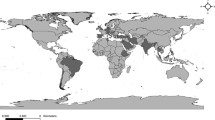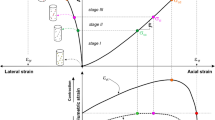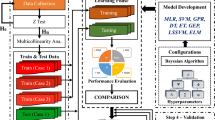Abstract
The estimation of rock strength is one of the most important basic requirements in rock engineering design and analysis. In this study, six different data-driven machine learning (ML) models to predicate the major principal stress (\({\sigma }_{1}\)) at the failure of intact rock material under the polyaxial (true triaxial) stress condition are introduced and investigated. In this regard, multiple linear regression, support vector machine, random forest (RF), extreme gradient boosting (XGBoost), K-nearest neighbors, and multivariate adaptive regression splines (MARS) methods are developed based on uniaxial compressive strength (\({\sigma }_{c}\)), minor principal stress (\({\sigma }_{3}\)), and intermediate principal stress (\({\sigma }_{2}\)) as the input of the proposed models. 80% out of 930 polyaxial compiled datasets of 29 rocks from the literature are used to train the data-oriented rock failure models and the remaining, i.e., 20% datasets are considered to test the performance of established polyaxial rock failure models. Comparison of the performance results indicates XGBoost model outperforms other models with \({R}^{2}\) = 1, RMSE = 4.698 MPa, and AAREP = 0.460% in the training phase. However, RF model with \({R}^{2}\) = 0.992, RMSE = 29.620 MPa, and AAREP = 7.906% and XGBoost model with \({R}^{2}\) = 0.991, RMSE = 31.081 MPa, and AAREP = 7.462% perform superior than other models in the testing phase. Accordingly, feature importance, interaction, and visualization methods are used to perform XGboost model explanation and scrutinize the effect of \({\sigma }_{c}\), \({\sigma }_{3}\), and \({\sigma }_{2}\) on polyaxial rock failure strength, i.e., \({\sigma }_{1}\). Moreover, based on the interpretable MARS method and a wide-ranging database of laboratory tests, a new comprehensive and generalize equation for estimating polyaxial rock failure strength with \({R}^{2}\) = 0.98 is proposed. In general, employed ML techniques demonstrated their higher performance accuracy and generalization ability in predicting the failure strength of different intact rocks under polyaxial conditions compared with conventional failure criteria in the form of \({\tau }_{\mathrm{oct}}=f({\sigma }_{\mathrm{oct}})\) and \({\tau }_{\mathrm{oct}}=f({\sigma }_{m,2})\).













Similar content being viewed by others
References
Aha DW, Kibler D, Albert MK (1991) Instance-based learning algorithms. Mach Learn 6(1):37–66. https://doi.org/10.1007/BF00153759
Al-Ajmi A (2006) Wellbore stability analysis based on a new true-triaxial failure criterion. Doctoral dissertation, KTH
Al-Ajmi AM, Zimmerman RW (2005) Relation between the Mogi and the Coulomb failure criteria. Int J Rock Mech Min Sci 42(3):431–439. https://doi.org/10.1016/j.ijrmms.2004.11.004
Apley DW, Zhu J (2020) Visualizing the effects of predictor variables in black box supervised learning models. J R Stat Soc Ser B (stat Methodol) 82(4):1059–1086. https://doi.org/10.1111/rssb.12377
Aubertin M, Li L, Simon R, Khalfi S (1999) Formulation and application of a short-term strength criterion for isotropic rocks. Can Geotech J 36(5):947–960. https://doi.org/10.1139/t99-056
Aydin G, Karakurt I, Hamzacebi C (2014) Artificial neural network and regression models for performance prediction of abrasive waterjet in rock cutting. Int J Adv Manuf Technol 75(9–12):1321–1330. https://doi.org/10.1007/s00170-014-6211-y
Bahrami B, Mohsenpour S, Miri MA, Mirhaseli R (2017) Quantitative comparison of fifteen rock failure criteria constrained by polyaxial test data. J Pet Sci Eng 159:564–580. https://doi.org/10.1016/j.petrol.2017.09.065
Benz T, Schwab R (2008) A quantitative comparison of six rock failure criteria. Int J Rock Mech Min Sci 45(7):1176–1186
Benz T, Schwab R, Kauther RA, Vermeer PA (2008) A Hoek-Brown criterion with intrinsic material strength factorization. Int J Rock Mech Min Sci 45(2):210–222. https://doi.org/10.1016/j.ijrmms.2007.05.003
Bieniawski ZT (1974) Estimating the strength of rock materials. J South Afr Inst Min Metall 74(8):312–320
Bodonyi J (1970) Laboratory tests of certain rocks under axially symmetrical loading conditions. In: 2nd ISRM Int. Cong. of Rock Mech., Belgrade, p 2–17
Breiman L (2001) Random forest. Mach Learn 45(1):5–32. https://doi.org/10.1023/A:1010933404324
Chang C, Haimson B (2000) True triaxial strength and deformability of the German Continental Deep Drilling Program (KTB) deep hole amphibolite. J Geophys Res Solid Earth 105(8):18999–19013. https://doi.org/10.1029/2000JB900184
Chen T, Guestrin C (2016) XGBoost: a scalable tree boosting system. In: Proceedings of the 22nd ACM SIGKDD international conference on knowledge discovery and data mining 785:794.
Colmenares LB, Zoback MD (2002) A statistical evaluation of intact rock failure criteria constrained by polyaxial test data for five different rocks. Int J Rock Mech Min Sci 39(6):695–729. https://doi.org/10.1016/S1365-1609(02)00048-5
Coulomb CA (1776) Essai sur une application des rèles des maximis et minimis a quelques problems de statique. Memoires Acad. R des Sci 7:343–82
Drucker DC, Prager W (1952) Soil mechanics and plastic analysis or limit design. Q Appl Math 10(2):157–165
Du K, Yang C, Su R, Tao M, Wang S (2020) Failure properties of cubic granite, marble, and sandstone specimens under true triaxial stress. Int J Rock Mech Min Sci 130:104309. https://doi.org/10.1016/j.ijrmms.2020.104309
Ewy RT (1999) Wellbore-stability predictions by use of a modified Lade criterion. SPE Drill Complet 14(02):85–91. https://doi.org/10.2118/56862-PA
Fairhurst C (1964) On the validity of the ‘Brazilian’test for brittle materials. Int J Rock Mech Min Sci Geomech Abs 1(4):535–546. https://doi.org/10.1016/0148-9062(64)90060-9
Fathipour-Azar H (2021a) Machine learning assisted distinct element models calibration: ANFIS, SVM, GPR, and MARS approaches. Acta Geotech. https://doi.org/10.1007/s11440-021-01303-9
Fathipour-Azar H (2021b) Data-driven estimation of joint roughness coefficient (JRC). J Rock Mech Geotech Eng 13(6):1428–1437. https://doi.org/10.1016/j.jrmge.2021.09.003
Fathipour-Azar H (2022) New interpretable shear strength criterion for rock joints. Acta Geotech Accepted
Fathipour-Azar H, Torabi SR (2014) Estimating fracture toughness of rock (KIC) using artificial neural networks (ANNS) and linear multivariable regression (LMR) models. 5th Iranian Rock Mech. Conference
Fathipour-Azar H, Saksala T, Jalali SME (2017) Artificial neural networks models for rate of penetration prediction in rock drilling. J Struct Mech 50(3):252–255. https://doi.org/10.23998/rm.64969
Fathipour-Azar H, Wang J, Jalali SME, Torabi SR (2020) Numerical modeling of geomaterial fracture using a cohesive crack model in grain-based DEM. Comput Part Mech 7:645–654. https://doi.org/10.1007/s40571-019-00295-4
Feng XT, Kong R, Zhang X, Yang C (2019) Experimental study of failure differences in hard rock under true triaxial compression. Rock Mech Rock Eng 52(7):2109–2122. https://doi.org/10.1007/s00603-018-1700-1
Feng F, Li X, Du K, Li D, Rostami J, Wang S (2020) Comprehensive evaluation of strength criteria for granite, marble, and sandstone based on polyaxial experimental tests. Int J Geomech 20(2):04019155. https://doi.org/10.1061/(ASCE)GM.1943-5622.0001544
Franklin JA (1971) Triaxial strength of rock materials. Rock Mech 3(2):86–98. https://doi.org/10.1007/BF01239628
Friedman JH (1991) Multivariate adaptive regression splines. Ann Stat 19(1):1–67. https://doi.org/10.1214/aos/1176347963
Friedman JH (2001) Greedy function approximation: a gradient boosting machine. Ann Stat. https://doi.org/10.1214/aos/1013203451
Friedman JH, Popescu BE (2008) Predictive learning via rule ensembles. Ann Appl Stat 2(3):916–954. https://doi.org/10.1214/07-AOAS148
Goldstein A, Kapelner A, Bleich J, Pitkin E (2015) Peeking inside the black box: visualizing statistical learning with plots of individual conditional expectation. J Comput Graph Stat 24(1):44–65. https://doi.org/10.1080/10618600.2014.907095
Haimson B, Chang C (2000) A new true triaxial cell for testing mechanical properties of rock, and its use to determine rock strength and deformability of Westerly granite. Int J Rock Mech Min Sci 37(1–2):285–296. https://doi.org/10.1016/S1365-1609(99)00106-9
Hobbs DW (1964) The strength and the stress-strain characteristics of coal in triaxial compression. J Geo 72(2):214–231. https://doi.org/10.1086/626977
Hoek E, Brown ET (1980) Empirical strength criterion for rock masses. J Geotech Eng Div 106(9):1013–1035. https://doi.org/10.1061/AJGEB6.0001029
Hoek E, Carranza-Torres C, Corkum B (2002) Hoek-Brown failure criterion-2002 edition. In: Proceeding NARMS-TAC 1(1):267–273
Jaiswal A, Shrivastva BK (2012) A generalized three-dimensional failure criterion for rock masses. J Rock Mech Geotech Eng 4(4):333–343. https://doi.org/10.3724/SP.J.1235.2012.00333
Jiang H (2017a) A failure criterion for rocks and concrete based on the Hoek-Brown criterion. Int J Rock Mech Min Sci 95:62–72. https://doi.org/10.1016/j.ijrmms.2017.04.003
Jiang H (2017b) Three-dimensional failure criteria for rocks based on the Hoek-Brown criterion and a general lode dependence. Int J Geomech 17(8):04017023. https://doi.org/10.1061/(ASCE)GM.1943-5622.0000900
Jiang H (2018) Simple three-dimensional Mohr-Coulomb criteria for intact rocks. Int J Rock Mech Min Sci 105:145–159. https://doi.org/10.1016/j.ijrmms.2018.01.036
Jiang H, Xie YL (2012) A new three-dimensional Hoek-Brown strength criterion. Acta Mech Sin 28(2):393–406. https://doi.org/10.1007/s10409-012-0054-2
Jiang H, Zhao J (2015) A simple three-dimensional failure criterion for rocks based on the Hoek-Brown criterion. Rock Mech Rock Eng 48(5):1807–1819
Jiang H, Wang X, Xie Y (2011) New strength criteria for rocks under polyaxial compression. Can Geotech J 48(8):1233–1245. https://doi.org/10.1139/t11-034
Johnston IW (1985) Strength of intact geomechanical materials. J Geotech Eng 111(6):730–749. https://doi.org/10.1061/(ASCE)0733-9410(1985)111:6(730)
Kaunda R (2014) New artificial neural networks for true triaxial stress state analysis and demonstration of intermediate principal stress effects on intact rock strength. J Rock Mech Geotech Eng 6(4):338–347. https://doi.org/10.1016/j.jrmge.2014.04.008
Kim MK, Lade PV (1984) Modelling rock strength in three dimensions. Int J Rock Mech Min Sci Geomech Abs 21(1):21–33
Kwasniewski M, Takahashi M, Li X (2003) Volume changes in sandstone under true triaxial compression conditions. In: Proceedings of the ISRM 2003, technology roadmap for rock mechanics, South African Institute of Mining and Metallurgy, 683–88
Lade PV, Duncan JM (1975) Elastoplastic stress-strain theory for cohesionless soil. J Geotech Eng Div 101(10):1037–1053. https://doi.org/10.1061/AJGEB6.0000204
Lee YK, Pietruszczak S, Choi BH (2012) Failure criteria for rocks based on smooth approximations to Mohr-Coulomb and Hoek-Brown failure functions. Int J Rock Mech Min Sci 56:146–160. https://doi.org/10.1016/j.ijrmms.2012.07.032
Li C, Li C, Zhao R, Zhou L (2021a) A strength criterion for rocks. Mech Mater 154:103721. https://doi.org/10.1016/j.mechmat.2020.103721
Li H, Guo T, Nan Y, Han B (2021b) A simplified three-dimensional extension of Hoek-Brown strength criterion. J Rock Mech Geotech Eng. https://doi.org/10.1016/j.jrmge.2020.10.004
Liolios P, Exadaktylos G (2013) Comparison of a hyperbolic failure criterion with established failure criteria for cohesive-frictional materials. Int J Rock Mech Min Sci 63:12–26. https://doi.org/10.1016/j.ijrmms.2013.06.005
Lu A, Zhang N, Zeng G (2020) An extension failure criterion for brittle rock. Adv Civ Eng. https://doi.org/10.1155/2020/8891248
Ma X, Haimson BC (2016) Failure characteristics of two porous sandstones subjected to true triaxial stresses. J Geophys Res Solid Earth 121(9):6477–6498. https://doi.org/10.1002/2016JB012979
Ma L, Li Z, Wang M, Wu J, Li G (2020) Applicability of a new modified explicit three-dimensional Hoek-Brown failure criterion to eight rocks. Int J Rock Mech Min Sci 133:104311. https://doi.org/10.1016/j.ijrmms.2020.104311
Melkoumian N, Priest SD, Hunt SP (2009) Further development of the three-dimensional Hoek-Brown yield criterion. Rock Mech Rock Eng 42(6):835–847. https://doi.org/10.1007/s00603-008-0022-0
Meyer JP, Labuz JF (2013) Linear failure criteria with three principal stresses. Int J Rock Mech Min Sci 60:180–187. https://doi.org/10.1016/j.ijrmms.2012.12.040
Michelis P (1985) Polyaxial yielding of granular rock. J Eng Mech 111(8):1049–1066. https://doi.org/10.1061/(ASCE)0733-9399(1985)111:8(1049)
Mogi K (1967) Effect of the intermediate principal stress on rock failure. J Geophys Res 72(20):5117–5131. https://doi.org/10.1029/JZ072i020p05117
Mogi K (1971a) Effect of the triaxial stress system on the failure of dolomite and limestone. Tectonophysics 11(2):111–127. https://doi.org/10.1016/0040-1951(71)90059-X
Mogi K (1971b) Fracture and flow of rocks under high triaxial compression. J Geophys Res 76(5):1255–1269. https://doi.org/10.1029/JB076i005p01255
Mogi K (2007) Experimental rock mechanics. Tailor and Francis, United Kingdom
Mohr O (1900) Welche Umstände bedingen die Elastizitätsgrenze und den Bruch eines Materials? Z Ver Deut Ing 44:1524–1530
Molnar C (2019) Interpretable machine learning. A guide for making black box models explainable. Leanpub. https://christophm.github.io/interpretable-ml-book/.
Moshrefi S, Shahriar K, Ramezanzadeh A, Goshtasbi K (2018) Prediction of ultimate strength of shale using artificial neural network. J Min Environ 9(1):91–105. https://doi.org/10.22044/JME.2017.5790.1390
Murrell SAF (1965) The effect of triaxial stress systems on the strength of rocks at atmospheric temperatures. Geophys J Int 10(3):231–281. https://doi.org/10.1111/j.1365-246X.1965.tb03155.x
Nadai A (1950) Theory of flow and fracture of solids, vol 1. McGraw-Hill, New York
Pan XD, Hudson JA (1988) A simplified three dimensional Hoek-Brown yield criterion. In: Rock Mech and power plants. A.A. Balkema, 95–103
Paul B (1961). A Modification of the Coulomb-Mohr Theory of Fracture. https://doi.org/10.1115/1.3641665
Pobwandee T (2010) Effects of intermediate principal stress on compressive strength and elasticity of phra wihan sandstone. Master of engineering, Suranaree University of Technology, Thailand
Pobwandee T, Fuenkajorn K (2011) Effect of intermediate principal stresses on compressive strength of Phra Wihan sandstone. In: Proceedings of the third Thailand symposium on rock mechanics. March, 10–11
Priest SD (2005) Determination of shear strength and three-dimensional yield strength for the Hoek–Brown criterion. Rock Mech Rock Eng 38(4):299–327. https://doi.org/10.1007/s00603-005-0056-5
Priest SD (2010) Comparisons between selected three-dimensional yield criteria applied to rock. Rock Mech Rock Eng 43(4):379–389. https://doi.org/10.1007/s00603-009-0064-y
Priest S (2012) Three-dimensional failure criteria based on the Hoek–Brown criterion. Rock Mech Rock Eng 45(6):989–993. https://doi.org/10.1007/s00603-012-0277-3
Rafiai H (2011) New empirical polyaxial criterion for rock strength. Int J Rock Mech Min Sci 48(6):922–931. https://doi.org/10.1016/j.ijrmms.2011.06.014
Rafiai H, Jafari A (2011) Artificial neural networks as a basis for new generation of rock failure criteria. Int J Rock Mech Min Sci 48(7):1153–1159. https://doi.org/10.1016/j.ijrmms.2011.06.001
Rafiai H, Jafari A, Mahmoudi A (2013) Application of ANN-based failure criteria to rocks under polyaxial stress conditions. Int J Rock Mech Min Sci 59:42–49. https://doi.org/10.1016/j.ijrmms.2012.12.003
Rukhaiyar S, Samadhiya NK (2017a) A polyaxial strength model for intact sandstone based on Artificial Neural Network. Int J Rock Mech Min Sci 95:26–47. https://doi.org/10.1016/j.ijrmms.2017.03.012
Rukhaiyar S, Samadhiya NK (2017b) Strength behaviour of sandstone subjected to polyaxial state of stress. Int J Min Sci Technol 27(6):889–897. https://doi.org/10.1016/j.ijmst.2017.06.022
Sheorey PR (1997) Empirical rock failure criteria. Balkema, Rotterdam
Sheorey PR, Biswas A, Choubey VD (1989) An empirical failure criterion for rocks and jointed rock masses. Eng Geo 26(2):141–159. https://doi.org/10.1016/0013-7952(89)90003-3
Singh M, Raj A, Singh B (2011) Modified Mohr–Coulomb criterion for non-linear triaxial and polyaxial strength of intact rocks. Int J Rock Mech Min Sci 48(4):546–555. https://doi.org/10.1016/j.ijrmms.2011.02.004
Singh A, Ayothiraman R, Rao KS (2020) Failure criteria for isotropic rocks using a smooth approximation of modified Mohr–Coulomb failure function. Geotech Geol Eng 38(4):4385–4404. https://doi.org/10.1007/s10706-020-01287-5
Single B, Goel RK, Mehrotra VK, Garg SK, Allu MR (1998) Effect of intermediate principal stress on strength of anisotropic rock mass. Tunnell Underground Sp Technol 13(1):71–79. https://doi.org/10.1016/S0886-7798(98)00023-6
Smart BDG, Somerville JM, Crawford BR (1999) A rock test cell with true triaxial capability. Geotech Geol Eng 17(3):157–176. https://doi.org/10.1023/A:1008969308711
Sriapai T, Walsri C, Fuenkajorn K (2013) True-triaxial compressive strength of Maha Sarakham salt. Int J Rock Mech Min Sci 61:256–265. https://doi.org/10.1016/j.ijrmms.2013.03.010
Stavropoulou M, Liolios P, Exadaktylos G (2012) Calibration of the triaxial hyperbolic Mohr-Coulomb elastoplastic model parameters on laboratory rock mechanics tests. Int J Geomech 12(6):618–631. https://doi.org/10.1061/(ASCE)GM.1943-5622.0000182
Takahashi M, Koide H (1989) Effect of the intermediate principal stress on strength and deformation behavior of sedimentary rocks at the depth shallower than 2000 m. In: Maury V, Fourmaintraux D (eds) Rock at great depth. Balkema, A.A, pp 19–26
Taylor KE (2001) Summarizing multiple aspects of model performance in a single diagram. J Geophys Res Atmos 106(7):7183–7192. https://doi.org/10.1029/2000JD900719
Vapnik V (1995) The nature of statistical learning. Springer, New York
Vapnik V, Vapnik V (1998) Statistical learning theory. Springer, New York
Walsri C (2009) Compressive strength of sandstone under true triaxial stress states. Suranaree University of Technology, Thailand, Master of Engineering
Walsri C, Poonprakon P, Thosuwan R, Fuenkajorn K (2009) Compressive and tensile strengths of sandstones under true triaxial stresses. In Proceeding 2nd Thailand Symposium on Rock Mechanics. Chonburi, Thailand 2:199–218
Wang R, Kemeny JM (1995) A new empirical criterion for rock under polyaxial compressive stresses. In: Daemen and Schultz (ed) Rock mechanics. Balkema, Rotterdam, 453–458
Wiebols GA, Cook NGW (1968) An energy criterion for the strength of rock in polyaxial compression. Int J Rock Mech Min Sci Geomech Abs 5(6):529–549. https://doi.org/10.1016/0148-9062(68)90040-5
Wu S, Zhang S, Zhang G (2018) Three-dimensional strength estimation of intact rocks using a modified Hoek-Brown criterion based on a new deviatoric function. Int J Rock Mech Min Sci 107:181–190. https://doi.org/10.1016/j.ijrmms.2018.04.050
Yao Y, Hu J, Zhou A, Luo T, Wang N (2015) Unified strength criterion for soils, gravels, rocks, and concretes. Acta Geotech 10(6):749–759. https://doi.org/10.1007/s11440-015-0404-x
You M (2009) True-triaxial strength criteria for rock. Int J Rock Mech Min Sci 46(1):115–127. https://doi.org/10.1016/j.ijrmms.2008.05.008
Yu MH, Zan YW, Zhao J, Yoshimine M (2002) A unified strength criterion for rock material. Int J Rock Mech Min Sci 39(8):975–989. https://doi.org/10.1016/S1365-1609(02)00097-7
Yudhbir Y, Lemanza W, Prinzl F (1983) An empirical failure criterion for rock masses. In: Proceding of the 5th International Cong. on Rock Mech., Balkema, Rotterdam 1983;1:B1–8.
Zeng F, Li Y, Labuz JF (2018) Paul-Mohr-Coulomb failure criterion for geomaterials. J Geotech Geoenviron Eng 144(2):06017018. https://doi.org/10.1061/(ASCE)GT.1943-5606.0001829
Zhang L (2008) A generalized three-dimensional Hoek-Brown strength criterion. Rock Mech Rock Eng 41(6):893–915. https://doi.org/10.1007/s00603-008-0169-8
Zhang L, Zhu H (2007) Three-dimensional Hoek-Brown strength criterion for rocks. J Geotech Geoenviron Eng 133(9):1128–1135. https://doi.org/10.1061/(ASCE)1090-0241(2007)133:9(1128)
Zhang L, Cao P, Radha KC (2010a) Evaluation of rock strength criteria for wellbore stability analysis. Int J Rock Mech Min Sci 47(8):1304–1316. https://doi.org/10.1016/j.ijrmms.2010.09.001
Zhang Q, Shuilin WANG, Xiurun GE, Hongying WANG (2010b) Modified Mohr-Coulomb strength criterion considering rock mass intrinsic material strength factorization. Min Sci Technol (china) 20(5):701–706. https://doi.org/10.1016/S1674-5264(09)60266-0
Zhang Q, Zhu H, Zhang L (2013) Modification of a generalized three-dimensional Hoek-Brown strength criterion. Int J Rock Mech Min Sci 59:80–96. https://doi.org/10.1016/j.ijrmms.2012.12.009
Zhang S, Wu S, Zhang G (2020a) Strength and deformability of a low-porosity sandstone under true triaxial compression conditions. Int J Rock Mech Min Sci 127:104204. https://doi.org/10.1016/j.ijrmms.2019.104204
Zhang W, Zhang R, Wu C, Goh ATC, Lacasse S, Liu Z, Liu H (2020b) State-of-the-art review of soft computing applications in underground excavations. Geosci Front 11(4):1095–1106. https://doi.org/10.1016/j.gsf.2019.12.003
Zhang W, Wu C, Li Y, Wang L, Samui P (2021) Assessment of pile drivability using random forest regression and multivariate adaptive regression splines. Georisk Assess Manag Risk Eng Syst Geohazards 15(1):27–40. https://doi.org/10.1080/17499518.2019.1674340
Zhou S (1994) A program to model the initial shape and extent of borehole breakout. Comput Geosci 20(7–8):1143–1160. https://doi.org/10.1016/0098-3004(94)90068-X
Zhu C, Zhao H, Ru Z (2015) LSSVM-Based rock failure criterion and its application in numerical simulation. Math Probl Eng. https://doi.org/10.1155/2015/246068
Author information
Authors and Affiliations
Corresponding author
Ethics declarations
Conflict of interest
The author declares that he has no known competing financial interests or personal relationships that could have appeared to influence the work reported in this paper.
Additional information
Publisher's Note
Springer Nature remains neutral with regard to jurisdictional claims in published maps and institutional affiliations.
Rights and permissions
About this article
Cite this article
Fathipour-Azar, H. Polyaxial Rock Failure Criteria: Insights from Explainable and Interpretable Data-Driven Models. Rock Mech Rock Eng 55, 2071–2089 (2022). https://doi.org/10.1007/s00603-021-02758-8
Received:
Accepted:
Published:
Issue Date:
DOI: https://doi.org/10.1007/s00603-021-02758-8




